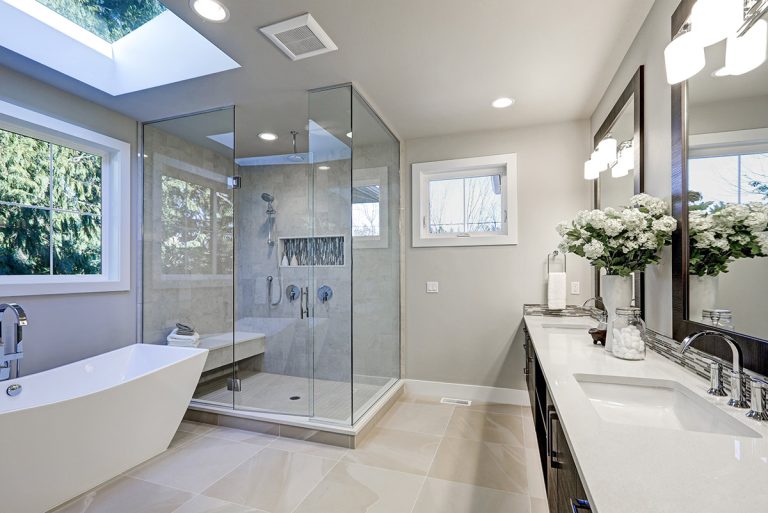Waterproofing is necessary for bathrooms and public washrooms with running water and flushing toilets. Without waterproofing by a licensed expert, grout will absorb moisture leading to mold growth. Also, leaking water can get into the substructure and cause significant structural damage.
Typically, waterproofing happens during construction, but if you already have water damage, skilled professionals can use specialized waterproofing tools and products to repair and restore your bathroom. Adding an access panel during this process will protect components in your bathroom walls from water damage and provide convenient access for plumbing maintenance BA-ADWT-SS Airtight Watertight Stainless Steel Access Door is ideal since it’s watertight and corrosion-resistant, perfect for wet areas!
Excess condensation from leaking plumbing fixtures can lead to the decay of wood products, disintegration, and discoloration. Having a plumbing access door installed makes it a lot easier for fast repairs and service.
Why Does Waterproofing Your Bathroom Matter?
- Protects your building from structural damage
- Reduces the risk of leaks and development of mold
- Easier to maintain and keep clean
- Increases the value of your property
- Improves air quality by reducing humidity and musty smells
- Keeps the space comfortable and aesthetically pleasing
- Reduces your water bill by preventing water loss
- Limits damage caused by burst pipes, overflowing sinks, and bathtubs
Advantages of Waterproofing Your Bathroom
Prevents Major Damage: Waterproofing your bathroom prevents structural damage that will cost thousands to repair. When left unchecked, extensive water damage may require completely gutting your bathroom.
Saves on Future Repair Costs: If you already have a leak, a licensed waterproofing technician can use specialized tools and products to repair the damage and restore your bathroom, preventing further damage that can cost thousands to repair.
Preserves Your Health: Waterproofing your bathroom prevents mold and infestation of microorganisms and pets that could jeopardize your health.
Steps to Waterproofing Your Bathroom
Step 1: Check Local Building Codes: Check local building codes which detail the exact requirements.
Step 2: Hire a Professional: In some areas, standards require waterproofing to be done by a licensed expert.
Step 3: Create a Barrier: Waterproofing your bathroom involves adding a waterproof membrane to form a barrier for the walls, floor, and shower area. Your technician will use approved materials for the subfloor before applying the membrane by spraying, painting, or laying down sheets. A polyurethane (PU) waterproof membrane is stretchable and flexible and helps to prevent cracks in the subfloor.
Step 4: Apply a Liquid Sealant: Once the membrane is applied, your technician will use a liquid sealant for the tiles.
Step 5: Seal Gaps with Silicone: Finally, applying silicone sealant will seal gaps so water can’t leak through.
Step 6: Eliminate Moisture: Exhaust fans also help to eliminate the moisture in the air, and porcelain and ceramic are water-resistant, making them promising materials for your bathroom floors and walls. Bathroom skylights are another choice that helps with ventilation and improves the ambiance.
Waterproof Flooring Options
Remember that not all floor materials repel water – so ask about treating your existing floor tiles or installing water-resistant materials. Remember, even a tiny amount of water trapped under your flooring can cause problems. Mold can develop if your bathroom is damp due to poor ventilation.
So, choosing mold-resistant vinyl flooring is a good option since even ceramic tile, while water-resistant, is only waterproof if you have it treated with a sealer. The issue arises when grout lines erode and water seeps down, causing your floors to shift and become uneven. So, add sealers on any porous surfaces or opt for a fully waterproof solution.
Water-Resistant Bathroom Wall Solutions
If you are thinking about painting your bathroom walls, thoroughly clean the surfaces first. If there is existing mold, you cannot paint over it – the mold will stop the paint from sticking to the wall and end up flaking off. Instead, clean the area with your choice of bleach, white vinegar, or baking soda, carefully scrubbing with a small brush. Then rinse thoroughly with clean water.
Because your bathroom experiences high moisture and condensation levels, you may consider a specialized moisture-resistant paint that can tolerate a damp environment or semi-gloss mold and mildew-proof paint. Fully waterproof bathtub paint is another option, along with specialized epoxy acrylic paint for basins and tiles. But before painting, clean all surfaces and apply mildew-resistant primer.
If you use latex paint, remember that it is less durable than oil-based paint but easier to use. Oil-based paint is difficult to apply and clean up if you spill it – but it offers a more durable and moisture-resistant solution.
Protect Your Investment by Waterproofing Your Bathroom
Prevent water damage by installing a proper subfloor, applying waterproof membranes, using liquid sealant, and applying silicone to any gaps. Install an access door for quick access for service and maintenance and use exhaust fans to remove moisture from the air. Preparing your bathroom with professional waterproofing techniques will prevent costly repairs and keep your bathroom in good working order.

